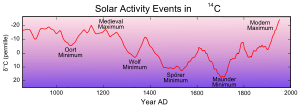
Maunder Minimum
Background Information
The articles in this Schools selection have been arranged by curriculum topic thanks to SOS Children volunteers. Sponsor a child to make a real difference.
The Maunder Minimum is the name given to the period roughly from 1645 to 1715, when sunspots became exceedingly rare, as noted by solar observers of the time. It is named after the solar astronomer Edward W. Maunder (1851–1928) who discovered the dearth of sunspots during that period by studying records from those years. During one 30-year period within the Maunder Minimum, for example, astronomers observed only about 50 sunspots, as opposed to a more typical 40,000–50,000 spots.
Sunspot observations
The Maunder Minimum occurred between 1645 and 1715 when only about 50 spots appeared as opposed to the typical 40,000–50,000 spots. The minima counts for 10-year periods from 1610– 1681 are as follows:
| Decade | Sunspots |
|---|---|
| 1610 | 9 |
| 1620 | 6 |
| 1630 | 9 |
| 1640 | 2 |
| 1650 | 3 |
| 1660 | 1 |
| 1670 | 0 |
| 1680 | 1 |
During the Maunder Minimum enough sunspots were sighted so that 11-year cycles could be extrapolated from the count. The maxima occurred in 1674, 1684, 1695, 1705 and 1716.
The sunspot activity was then concentrated in the southern hemisphere of the Sun, except for the last cycle when the sunspots appeared in the northern hemisphere too.
According to Spörer's law, at the start of a cycle spots appear at ever lower latitudes, until they average at about lat. 15° at solar maximum. The average then continues to drift lower to about 7° and after that, while spots of the old cycle fade, new cycle spots start appearing again at high latitudes.
The visibility of these spots is also affected by the velocity of the sun's rotation at various latitudes:
| Solar latitude |
Rotation period (days) |
|---|---|
| 0° | 24.7 |
| 35° | 26.7 |
| 40° | 28.0 |
| 75° | 33.0 |
Visibility is somewhat affected by observations being done from the ecliptic. The ecliptic is inclined 7° from the plane of the Sun's equator (latitude 0°).
Little Ice Age
The Maunder Minimum coincided with the middle — and coldest part — of the so-called Little Ice Age, during which Europe and North America, and perhaps much of the rest of the world, were subjected to bitterly cold winters. Whether there is a causal connection between low sunspot activity and cold winters is the subject of ongoing debate (e.g. see Global Warming).
Other observations
The lower solar activity during the Maunder Minimum also affected the amount of cosmic radiation reaching the Earth. The resulting change in the production of carbon-14 during that period caused an inaccuracy in radiocarbon dating until this effect was discovered.
Solar activity also affects the production of beryllium-10, and variations in that cosmogenic isotope are studied as a proxy for solar activity.
Other historical sunspot minima have been detected either directly or by the analysis of carbon-14 in ice cores or tree rings; these include the Sporer Minimum ( 1450– 1540), and less markedly the Dalton Minimum (1790–1820). In total there seem to have been 18 periods of sunspot minima in the last 8,000 years, and studies indicate that the sun currently spends up to a quarter of its time in these minima.
One recently published paper, based on an analysis of a Flamsteed drawing, suggests that the Sun's rotation slowed in the deep Maunder minimum ( 1666– 1700).



